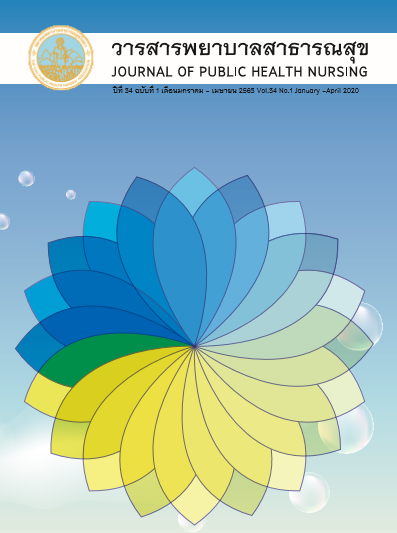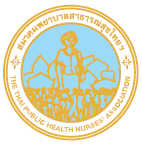A Vision Screening to Address Refractive Error of Primary School Students in a School of Bangkok Metropolitan Province
Keywords:
Eye screening, Refractive error, Primary studentsAbstract
Abnormal vision affects student learning and should be addressed early in the educational process. This research aimed to assess vision screening practices and suggest guidelines to address refractive error in grade 5 students by studying students attending Anubansamsen School, Bangkok. The researcher collected data from health examination forms and performed an assessment of visual acuity (VA). The data was collected from May to December 2013. Of 143 students who participated in this study, 69 were boys (48.3%) and 74 were girls (51.7%). The outcome was compared with previous screening data when students were in grade 1 (2009), and grade 3 (2011). The tools of this study were a Snellen chart or an Allen card and an Occluder, to identify refractive error. Outcomes were divided into three categories: normal vision (20/20 visual acuity), mild visual impairment (20/30 visual acuity), and poor vision (≤20/40 visual acuity). 107 students (74.8%) had normal vision, 11 students (7.7%) had mild visual impairment and 25 students (17.5 %) had poor vision.
Reviewing data over the last five years showed that the vision of the 107 students (88.4%) who had normal vision at grade 1 was not changed. On the other hand, the vision of the 6 students (46.2%) with mild visual impairment and the 9 students (100%) with poor vision had deteriorated. In addition, new cases with poor vision were reported at each screening visit. For example, in 2009, 2011, and 2013, 9 students (6.3%) in grade 1, 6 students (4.2%) in grade 3, and 10 students (7%) in grade 5 had poor vision.
In summary, this study demonstrated that refractive error in school-aged children is a common problem and tends to increase over the years. As a result, students who have vision problems should be referred with regular follow-up. Following the guideline for preventive health care by the Royal College of Pediatricians of Thailand, the outcome of this study, it is suggested that school-aged children have vision checks at least every two years. This eye screening guideline should be incorporated into public school nurses’ usual workload.
References
World Health Organization, WHO. Sight test and glasses could dramatically improve the live of 150 million people with poor vision [Internet]. 2006 [cited 2020 May 7]. Available from http://www.who.int/mediacentre/news/releases/2006/pr55/en/print.html
Resnikoff S, Pascolini D, Mariotti SP, Pokharel GP. Global magnitude of visual impairment caused by uncorrected refractive errors in 2004. Bull World Health Organ 2008; 86(1): 63-70. doi: 10.2471/blt.07.041210.
Suthatip Empremsilapa. School health, health screening, and learning problems in school-aged students as holistic. In: Ruangdaraganon N, Rattarasarn C, Krairit O, editors. 4 years project of competency development of Thai population. “The way of disease prevention and health promotion”. Bangkok: Faculty of Medicine Ramathibodhi Hospital. (in Thai)
Yingyong P. Refractive errors survey in primary school children (6-12 year old) in 2 provinces: Bangkok and Nakhonpathom (one year result). Journal of the Medical Association of Thailand 2007; 93: 1205-10. (in Thai)
Bureau of Health Promotion, Department of Health, Ministry of Health. Guideline of health promotion and disease prevention in school-age children and teenagers. Bankok: Kaew Chao Chom Publications Center, Suan Sunandha Rajabhat University; 2014. (in Thai)
School-age Children and Youth Group, Department of Health, Ministry of Health. Guideline of health promotion of children and youth, and environmental health in school for local governance organizations. .Bankok: Kaew Chao Chom Publications Center, Suan Sunandha Rajabhat University; 2014. (in Thai)
Suthatip Empremsilapa. School health: health education and health services. In: Hansakunachai T, et al. Children development and behavior for general practioners. Bangkok: Beyond Enterprise; 2013. (in Thai)
The Royal College Pediatricians of Thailand, Pediatric Society of Thailand. Guideline in Child Health Supervision. Bangkok: Suppasan; 2014. (in Thai)
Lekskul A. Eye screening and eye problems in kindergarten and primary school-age children. Project of competency development of Thai population, Faculty of Medicine Ramathibodhi Hospital, Mahidol University. (Mimeographed). (in Thai)
Sukareechai S, Sukareechai C, Tapasanantana K. Health problems among students in one school in Pakkred district, Nonthaburi province. Thai Journal of Nursing 2011; 60(3): 53-62. (in Thai)
Kongsomboon K. Prevalence survey and factors effecting to eye abnormal in primary school children of
Watbuengthonglang School and Demonstration School, Srinakharinwirot University. Bangkok: Srinakharinwirot University; 1999. (in Thai)
Autthakornkovit C. Quality of lie of students with eye problems in Bankok Yai district, Bangkok. Journal of Public Health and Development 2006; 4(1): 45-52. (in Thai)
Tananuvat N, Worapong A, Kupat J, Manassakorn A, Pathanapitoon K, Wuttananikorn S. The results of eye problem survey in school children: project of ear, eye, and perception. Chiang Mai Medical Journal 2002; 41(2): 81-8. (in Thai)
Downloads
Published
How to Cite
Issue
Section
License
บทความที่ตีพิมพ์และแผนภูมิรูปภาพถือเป็นลิขสิทธิ์ของวารสารพยาบาลสาธารณสุข (Thai Public Health Nurses Association)







